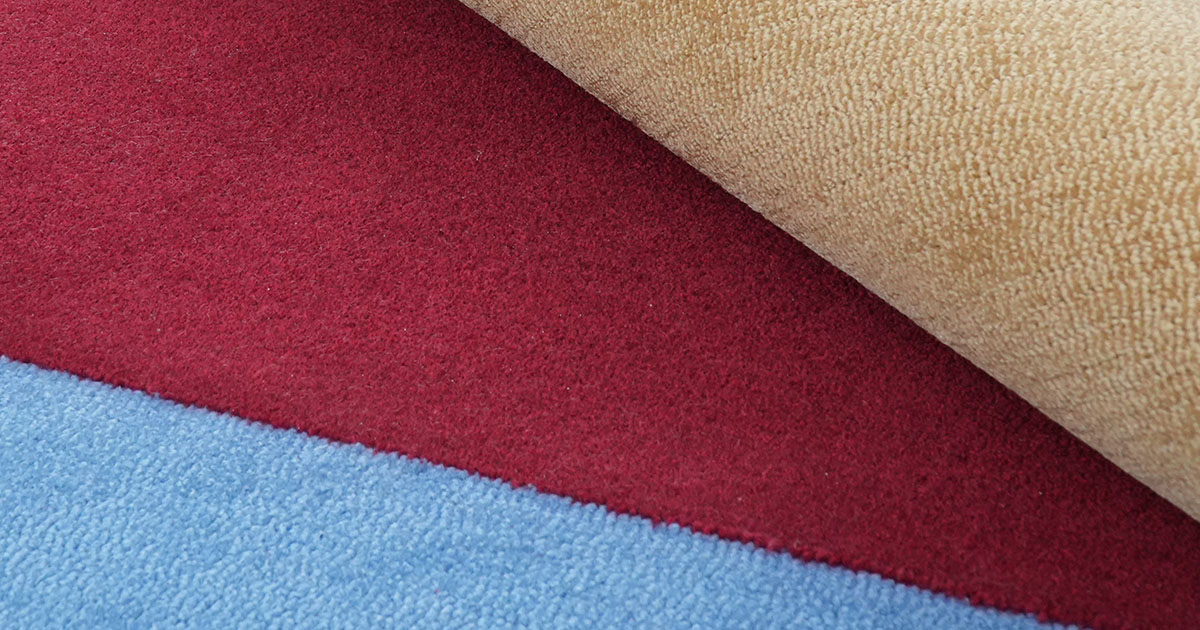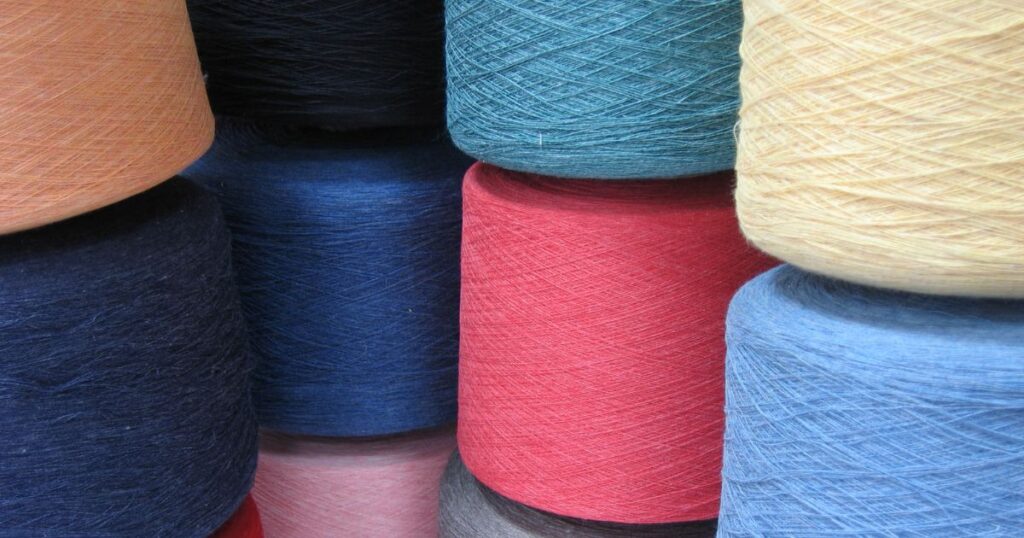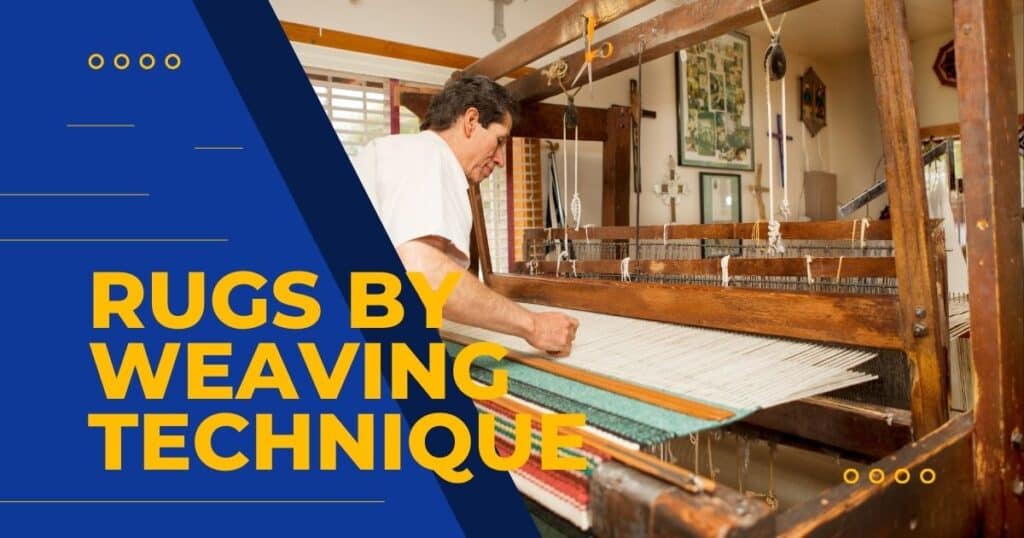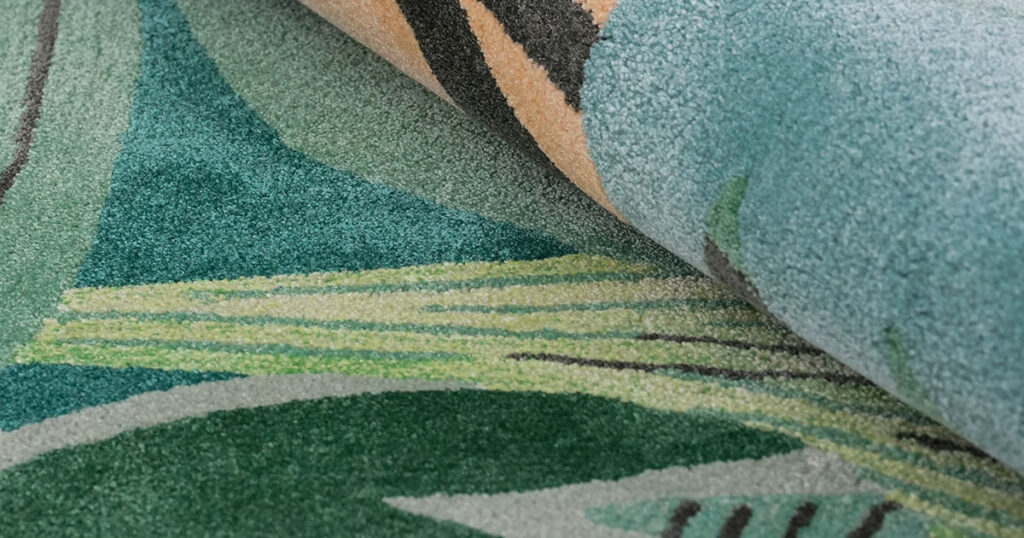Acrylic fiber is a versatile and affordable material for tufted rugs.
In this post, you’ll discover how acrylic fiber is made and its key properties.
We’ll explore the benefits and drawbacks of using acrylic in your rugs.
You’ll also learn when it’s best to choose acrylic over wool.
Ready to dive into the world of acrylic rugs?
Start reading now!
What Is Acrylic Yarn?
Acrylic is a synthetic fiber made from acrylonitrile, a petroleum-based chemical. Developed as an alternative to wool, it became popular in the mid-20th century as “art wool” because it mimics wool’s look and feel better than other synthetics.
Chemically, acrylic is made from acrylonitrile polymers—essentially a type of plastic. It emerged in the 1960s as a popular carpet material under trade names like Orlon® and Dralon®. Though its use in broadloom carpet has waned in favor of nylon and other synthetics, acrylic remains common in tufted area rugs.
The fiber is soft, fluffy, and typically spun in staple fiber form (not filament) to create a wool-like texture. It’s specifically designed to imitate wool’s appearance and feel while being produced at a lower cost.
How Acrylic Fiber Is Made
The production process involves several key steps:
Polymerization: Acrylonitrile is combined with other chemicals and polymerized under specific temperature and pressure conditions.
Spinning: The acrylic polymer is melted and extruded through a spinneret (a metal plate with many small holes). This creates long, thin strands of acrylic fiber. The fibers are either wet spun in a chemical solution or dry spun in a stream of heated gas to solidify them.
Drawing: The spun fibers are stretched to align the polymer chains and increase strength and durability.
Crimping: The fibers are crimped or texturized to create a fluffy, wool-like texture. This crimping adds bulk and spring, intentionally mimicking wool’s natural crimp.
Cutting: The crimped fibers are cut to desired lengths for spinning into yarn, typically a few millimeters to several centimeters depending on the end use.
The fibers are often solution-dyed or dyed in bulk, giving acrylic yarn its strong, vivid colors that become part of the fiber itself. This technique is why acrylic can achieve such bright, fade-resistant colors that wool sometimes cannot.
Key Advantages for Tufted Rugs
Wool-Like Aesthetics at Lower Cost
Acrylic gives you the look and feel of wool at a fraction of the price. From a distance, a well-made acrylic rug can be mistaken for wool. It has a soft, luxurious “hand” (touch) and a matte appearance similar to wool. This makes it perfect for those who love wool’s appearance but have budget constraints.
Soft and Springy Texture
Acrylic fibers create a plush, springy feel that’s comfortable underfoot. The yarn feels pleasantly soft with a fluffy texture that simulates wool’s cozy feel. Manufacturers specifically design acrylic to be springy and plush, making it comfortable for bare feet or sitting on.
Wide Color Range
Acrylic takes dyes exceptionally well and resists fading. You’ll find acrylic yarn in vibrant, fade-resistant colors that maintain their brightness even in sunlit rooms. Many outdoor fabrics use acrylic because it holds color in sunlight—this UV resistance makes it excellent for rugs in sunny spots where other fibers might bleach out.
Resistance to Mold, Mildew, and Pests
Unlike natural fibers, acrylic won’t attract moths or beetles—it’s not susceptible to insect damage. It’s also mildew-resistant since it doesn’t hold moisture like plant fibers or wool. In humid conditions or if a rug gets damp, acrylic will dry out without rotting. This makes acrylic rugs suitable for spaces like bathrooms, basements, or humid climates.
Stain and Soil Resistance
Acrylic is generally stain-resistant and easy to clean. It doesn’t have scales like wool that can trap dirt, and many acrylic rugs use solution-dyed fibers that inherently resist staining. It also generates very little static, which means it doesn’t attract as much dust or lint. You can clean acrylic with stronger cleaning agents than you could use on wool—normal carpet shampoos or mild detergents won’t damage it.
Moisture-Wicking Properties
Acrylic wicks moisture away rather than absorbing it. Whereas wool absorbs moisture, acrylic tends to let it evaporate. This is why acrylic is used in some bath mats or outdoor rugs—if it gets wet, it doesn’t stay soggy. This property helps avoid musty smells and makes the rug dry faster after cleaning.
Lightweight and Easy to Handle
Acrylic is lighter than wool, making rugs easier to move and rearrange. A thick acrylic-pile rug will weigh less than an equally thick wool rug. This can be particularly helpful for large area rugs, wall hangings, or rugs that need to be moved frequently for cleaning or rearranging furniture.
Limitations to Consider
Reduced Durability and Shorter Lifespan
The trade-off for acrylic’s affordability is lower durability. The fiber isn’t as strong or resilient as wool and doesn’t bounce back from foot traffic as well. Over time (sometimes a short time in busy areas), an acrylic rug will show wear—the pile may flatten in high-traffic spots and not fully recover. The fiber can break down with heavy use, leading to thinning or bald areas. Expect an acrylic rug to last significantly fewer years than an equivalent wool or nylon rug in the same location.
Pilling and Fuzzing Issues
Acrylic fibers have a strong tendency to fuzz or pill on the surface with abrasion. You’ll notice little balls of fiber (pills) on an acrylic rug in areas where people walk or sit frequently—similar to how a sweater pills. This happens because acrylic, like polyester, can abrade and each broken fiber can form a pill. Similarly, some acrylic rugs might “fuzz out,” creating a halo of fuzz on the rug surface that makes it look shabby unless regularly removed.
Less Resilient to Crushing
Heavy furniture can leave dents in an acrylic rug that are harder to revive. While wool or nylon might bounce back after a gentle steaming or just time, acrylic’s memory is weaker. Once compressed for a long period, the fibers may stay flat. Rotating furniture or using furniture coasters is extra important on acrylic rugs to avoid permanent indentations. The pile can mat down and lose its texture with regular use.
Heat Sensitivity
Acrylic has a relatively low melting point for a synthetic fiber (though not as low as polypropylene). Very high heat—such as an iron, hot pan, or even strong friction—can melt or fuse the fibers. One needs to be careful with things like cigarettes or sparks as well; acrylic can melt and form hard blobs if exposed to heat sources. Professional cleaning should avoid high-heat processes on acrylic rugs.
Oil Staining Problems (Oleophilia)
A notable weakness of acrylic is its oleophilia—it tends to attract and hold oily substances. Acrylic fibers can be easily stained by oil and grease. For instance, if you spill salad oil or if someone walks on the rug with greasy residues on their shoes, that oil can bind to the acrylic and be very hard to fully remove. Even skin oils from bare feet, over time, might cause discoloration or darkening in frequently trodden paths. Once an oil stain sets, you may need professional solvent cleaning to get it out.
Environmental Concerns
Acrylic is a synthetic polymer derived mainly from petrochemicals. It is not biodegradable—an acrylic rug won’t rot away over time (which is a double-edged sword; it’s durable in landfills, but that’s an environmental disadvantage). Producing acrylic involves chemical processes and solvents with environmental impacts from manufacturing. There aren’t robust recycling programs for used acrylic rugs; the fiber is less commonly recycled than something like polyester. If sustainability is a priority, acrylic isn’t the top choice—wool, recycled polyester, or Tencel would be preferable.
When to Choose Acrylic
Best Applications
Low to Medium Traffic Areas
Bedrooms (especially guest rooms with less daily use), home offices that aren’t heavily used, or wall-hanging rugs. Acrylic is best viewed as a “value” fiber—great for getting the look without the price.
Mid-Range Hand-Tufted Rugs
Acrylic is commonly found in mid-range hand-tufted rugs, especially those made in countries like China or India for export. Manufacturers often use it to produce rugs that mimic the look of expensive hand-tufted wool rugs at a lower price point.
Children’s Rooms and Novelty Rugs
Acrylic is popular for children’s rugs or themed rugs (like a bright fluffy nursery rug) since it’s soft, colorful, affordable, and can be cleaned with stronger agents than wool.
Bathroom Mats and Kitchen Rugs
Because acrylic dries quickly and resists mildew, it’s often used in bathroom rugs, door mats, or kitchen rugs. You can step out of the bath onto an acrylic tufted mat and it will handle the moisture better than a cotton rug.
Seasonal or Rotating Rugs
Acrylic works well for rugs you use only during part of the year or don’t expect to keep for decades. If you need a rug for just a few years (say, in a rental apartment or a dorm), acrylic is cost-effective.
Showrooms and Staging Areas
In spaces where rugs are used temporarily for decoration and visual appeal, affordable acrylic rugs can be swapped out frequently to refresh the look without breaking the bank.
When to Avoid Acrylic
High-Traffic Areas
Never choose acrylic for a high-traffic hallway, entryway, or commercial lobby—it will crush and soil too quickly. In commercial settings, pure acrylic is rare because of its wear limitations.
Under Heavy Furniture: Heavy furniture will leave permanent indentations in acrylic rugs that won’t spring back like wool or nylon would.
Areas Prone to Oil Spills
Kitchens, dining rooms, or homes with messy kids or pets might be challenging locations due to acrylic’s oleophilia issues. You might prefer a polyester rug in these cases, which handles oils a bit better than acrylic.
Long-Term Investments
If you’re looking for a rug that will last many years, consider wool instead. Acrylic should be understood as a medium-term solution rather than a lifetime investment.
Environmentally-Conscious Homes
If sustainability is important to you, acrylic isn’t the best choice due to its petroleum base and lack of biodegradability.
Final Thoughts
Acrylic yarn offers a practical middle ground for tufted rugs. It provides wool-like aesthetics and comfort at a lower price point, with good stain resistance and moisture handling. For decorative purposes or moderate use, acrylic rugs can be an excellent value.




